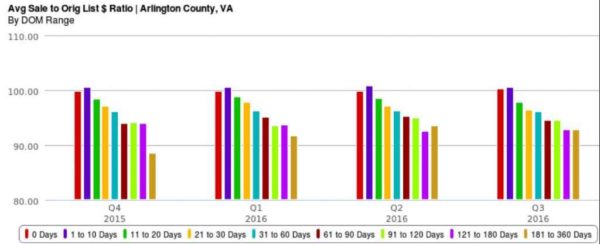Question: Why do I see different counts for the number of days a property has been listed for sale depending on the website I visit? What are the rules around agents resetting days on market?
Answer: Days on market is one of the most important data points when determining an appropriate offer:
- The longer a property has been on the market, the more likely a seller is to accept a reduced sale price
- Higher days on market = more leverage for buyers
- Sellers are most likely to fight for full asking price during the first couple of weeks
- You’re most likely to encounter multiple offers in the first week
The chart below shows the average sale price to original list price ratio based on the number of days a property has been on the market (100.00 = sold for full ask). On average, a property that sells in the first 10 days goes for above the asking price and after 30 days, the average seller takes a 4% reduction from the original asking price.
Days On Market – Property (DOMP)
DOMP is the number you want to focus on because it’s the number of days a property (based on the address) has been actively marketed for sale and it’s difficult to reset this number (see Resetting DOMP section).
Days On Market – MLS (DOMM)
DOMM is the number of days a listing has been actively marketed for sale. A listing is the individual record created by an agent to market a property for sale. It’s easy (and legal) for agents to reset this number as many times as they’d like by re-listing a property for sale. MRIS (see last week’s article for definition) makes it pretty easy for agents to do this and it’s common to see this action taken after a large price reduction because it gives the new listing more visibility to the public by, for example, popping back up in buyer’s automated searches as a new listing.
Resetting DOMP
The only way to reset DOMP is to withdraw a property from the market for 90+ days. This is an MRIS rule and may be different in other markets outside of the MRIS coverage area (VA, DC, MD, and parts of WV, PA, and DE). It’s somewhat common for a seller who’s not in a rush to remove an unsold listing from the market before the winter and allow the DOMP count to reset prior to re-listing in the spring.
How Do You Know?
Be careful, most public-facing websites use DOMM because they track the number of days the listing, not the property, has been on the market. Most good real estate search websites offer a “property history” section where you can view previous sales, when it’s been listed, taken off market or had a price reduction. MRIS has data fields specifically for DOMM and DOMP so your agent can easily provide this information and if you receive listing information from your agent directly from MRIS, those data fields are easily viewable.
Understanding the impact days on market has on final sale price is critical for buyers and sellers to maximize their value. The impact varies by locality and by the type of housing, so it’s important to also understand your market.
If you’d like a question answered in my weekly column, please send an email to [email protected]. To read any of my older posts, visit the blog section of my website at http://www.RealtyDCMetro.com.
Eli Tucker is a licensed Realtor in Virginia, Washington DC, and Maryland with Real Living At Home, 2420 Wilson Blvd #101 Arlington, VA 22201, (202) 518-8781.



